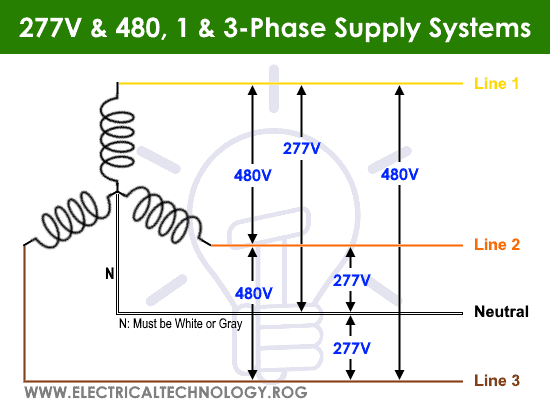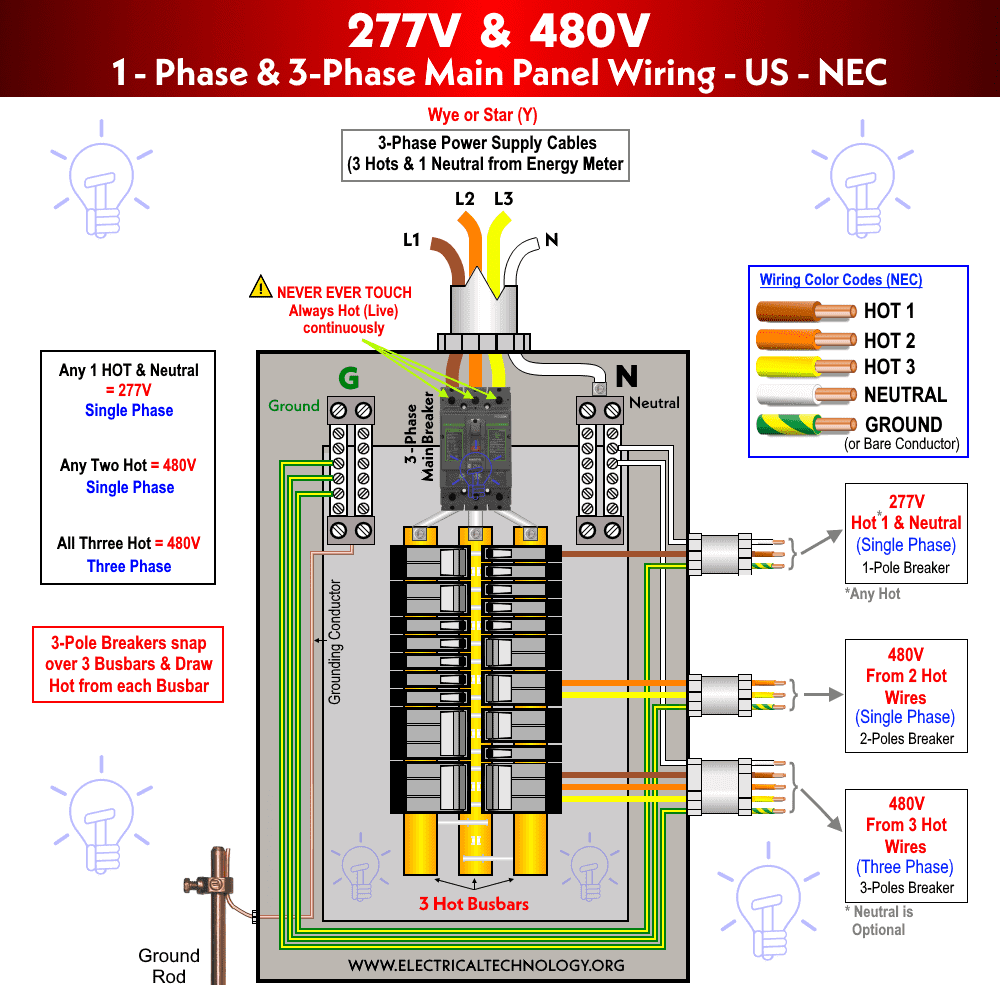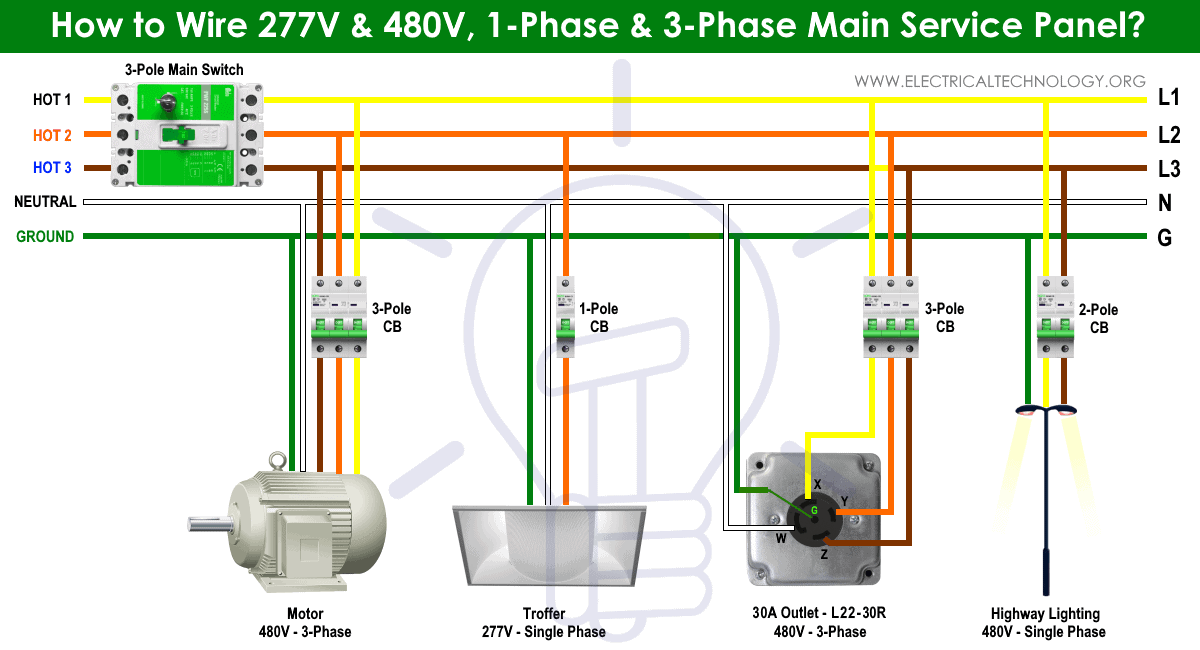How to Wire 277V & 480V, 1-Phase & 3-Phase, Commercial Main Service Panel?
Wiring a 480V & 277V, Single & Three Phase Main Breaker Box for Commercial Applications
What is 277 & 480V Commercial Supply?
277V is a standard single phase voltage derived from 480V three phase voltage system available in commercial applications. It can be achieved by three transformers connected in Wye (Star – connection) having a neutral point. The transformer’s secondary provides 277V single phase and 480V single phase and three phase voltage levels. Generally, 277V is not available in typical homes for residential purposes.
For 480V & 277V three phase supply, the electric power providers install three transformers in Wye-Wye configuration. The primary side of the transformer (configured in Wye) is connected to the 7.2 kV distribution lines. The output voltage levels of the transformer (from the secondary side wires in Wye) are 277V, 1-Phase and 480V, 1-Phase & 3-Phase. The three different levels of voltages are then used in the commercial buildings and industrial installations as per requirements of the consumer.
In this kind of power distribution system, the following three types of levels of voltage are available as three phase, four wires (three hot wires + neutral).
- 277V Single Phase, 3 Wires (One Hot wire + Neutral wire + Ground wire)
- 480V Single Phase, 3 Wires (Two out of phase Hot wires + Ground wire)
- 480V Three Phase, 4-5 Wires (Three out of phase Hot wires + Neutral wire + Ground wire)
480V can be achieved by high leg delta, four wires + neutral wire which provides 480V-415V-240V or open-delta configuration. Additionally, it can also be achieved by three wires without neutral as 480V-480V-480V. Another setup to provide 480V to the end user is four wires + neutral in wye configuration which provides 480V-480V-480V and 277V. For more details, you may read about the differences between Wye and Delta connections.
277V can also be achieved by using on site buck-boost transformer with other types of voltages such as installing an on-site (buck boost) transformer with 240V delta and 480V delta, in standard voltage system i.e. 277V can only be achieved without additional transformers in 480V-480V-480V and 277V (Wye connection). In this kind of system having both windings of T/F in Wye configuration, we will get the following 3-types of voltage levels based on the related math calculation.
- Voltage between two hot Phases = 480V (1-Φ).
- Voltage between Phase and Neutral = 480V / √3 = 227V (1-Φ).
- Voltage between three Phases = 277V x √3 = 480V (3-Φ).
Related Posts:
- How to Wire 120V & 240V Main Panel? Breaker Box Installation
- How to Wire 208V & 120V, 1-Phase & 3-Phase Main Panel?
- How to Wire 240V, 208V & 120V, 1 & 3-Phase, High Leg Delta Main Panel?
For this kind of service, the three phase supply including single phase supply from the secondary of the distribution transformer through insulated wires enters the meter box and safety switch and lastly enters to the main panel box. Each hot or line wire connects to a separate busbar in the panel box for further power distribution.
The color codes for three hot wires are Yellow, Orange and Blue for Hot1, Hot2 and Hot3, White or gray for neutral and green for ground.
Three poles, two poles and single pole circuit breakers are used to snap (i.e. in the metal tracks to hold the CB’s tightly) over three busbars which draws HOT from each busbar. There are additional two busbars for Neutral and Ground respectively. The ground wire is connected to the ground rod (see the full setup of earthing and grounding) for safety purposes.
In 277V and 480V, 1-Phase & 3-Phase, wiring systems, the available voltage levels are as follows inside the main service panel.
- Voltage between three hot wires (hot 1, hot 2 & hot 3) = 480V, 3-Phase
- Voltage between any two hot wires = 480V, 1-Phase
- Voltage between any hot wire and Neutral = 277V, 1-Phase
Click image to enlarge
Related Post:
- Single Phase Electrical Wiring Installation in Home according to NEC & IEC
- Three Phase Electrical Wiring Installation in Home – NEC & IEC
Let’s see how to wire 480V and 277V, single phase and three phase breakers and load circuits in the breaker box as follows.
How to Wire 277V, 1-Phase Circuits & Breakers?
The following tutorial shows how to wire a 277V single phase breaker derived from 480V three phase supply for commercial uses.
A 277V single phase can be achieved between any hot wire (either H1, H2 or H3) and Neutral. For example, in the fig below, we have connected a 277V troffer to a single pole MCB breaker as most troffers for lighting operate on 120V-277V. The single pole breaker is connected to hot2 wire, neutral and ground wire.
You can use and connect 277V single phase outlets such as L7-30R, L7-20R, L7-15R, 7-50R, 7-30R, 5-20R, 7-15R etc. All of them need three wires i.e. a hot from the breaker and ground + neutral wires.
How to Wire 480V, 1-Phase Circuits & Breakers?
In the same panel having 480V three phase and single phase, we may connect and install single phase 480V load circuits. To do so, simply connect the appliance (highway lighting circuit for example) via two poles breaker connected to any two hot wires (such as Hot1 and Hot 3) and ground wire. Connect the additional neutral wire if needed as per the circuit requirements.
For example, L8-20R, L8-30R outlets need three wires connection i.e. they can be connected without neutral e.g. two hot wires plus ground wire. Same is the case for single phase 277-480V surge found in water heaters, motors and parking lots for lighting circuits.
Related Posts:
- How to Wire and Install an Electrical Outlet Receptacle?
- How to wire a GFCI Outlet?
- How to Wire an AFCI Outlet?
How to Wire 480V, 3-Phase Circuits & Breakers?
For 480V, three phase circuits, we need four or five wires (three as out of phase hot i.e. all different lines). As shown in the following fig, we have two appliances e.g. three phase motor and L22-30R outlet. You can see that we have connected all the three hot wires in both cases. Additionally, we have connected neutral and gerund wires as well as per the circuit requirement. The same applies for 20 Amps outlets such as L22-20R.
You don’t always need the neutral wire in all cases for 480V three phase circuits as it depends on the rating and design of the appliances. For example, L19-30R, L19-20R, L16-30R, L16-20R, outlets can be connected via three hot wires + ground wire.
For proper installation of any other three phase device(s), read carefully the user manual before wiring for commercial supply systems and applications.
Click image to enlarge
Related Posts:
- How to Wire Combo Switch and Outlet?
- How to Wire GFCI Combo Switch and Outlet
- How to Wire an AFCI Combo Switch
Wiring Color Codes for 480 & 277V:
For 277V & 480V service, we have used different wire colors for illustration purposes only. Please follow the National Electric Codes i.e. NEC wiring color codes or other local area color codes.
In this tutorial, 277V and 480V, 1-phase and 3-phase circuits, we have used the NEC + general practice wiring color codes as follows.
- Brown = Hot 1 or Line 1
- Orange = Hot 2 or Line 2
- Yellow = Hot 3 or Line 3
- White = Neutral Wire
- Green or Green with Yellow stripes = Bare Conductor as Ground wire
Keep in mind that do not use green, green with yellow stripe or a bare conductor for those wires which carry voltage. Only and only use copper wire to reduce the resistance and heat instead of aluminum wires in the main panel box wiring. In addition, Hot, Phase and Line(s) represents the same thing i.e. those wires having live voltage.
Related Posts:
- How to Wire a Distribution Board with RCD (Residual Current Devices)
- How to Wire a GFCI Circuit Breaker?
- How to Wire an AFCI Breaker?
Safety Precautions
Disconnect the power source (and make sure it is really swathed OFF) before servicing, repairing or installing electrical equipment. To do so, switch off the main switch in the main panel box.
Never stand or touch wet and metal parts while repairing or installation of live circuits.
Read carefully all the cautions and instructions and follow them strictly while doing this tutorial or any other work in practical related to electrical works.
Always, use the right size cable and wire, proper size outlets and switch and suitable size of circuit breakers. You may also use the Wire and Cable size calculator to find the right gauge size.
Never ever try to play with electricity (as it is dangerous and can be fatal) without proper guidance and care. Do the installation and repairing work in presence of experienced persons having vast knowledge and good practice who knows how to deal with electricity.
Doing your own electrical work is dangerous as well as illegal in some cases. Contact the licensed electrician or the electric power supply provider before practicing any change/modification in electrical wiring connections.
The author will not be liable for any losses, injuries, or damages from the display or use of this information or if you try any circuit in the wrong format. So please! Be careful because it’s all about electricity and electricity is too dangerous.
Related Wiring Installation Tutorials:
- How to Size a Load Center, Panelboards and Distribution Board?
- How to Determine the Number of Circuit Breakers in a Panel Board?
- How to Determine the Right Size Capacity of a Subpanel?
- How to Wire a Single Element Water Heater and Thermostat?
- How to Wire 120V Water Heater Thermostat – Non-Simultaneous?
- How to Wire 120V Simultaneous Water Heater Thermostat?
- How to Wire 240V Water Heater Thermostat – Non-Continuous?
- How to Wire 240V Simultaneous Water Heater Thermostat?
- How to Wire 3-Phase Simultaneous Water Heater Thermostat?
- How to Wire 3-Phase Non-Simultaneous Water Heater Thermostat?
- How to Toggle Electric Water Heater Between 120V and 240V?
- Staircase Wiring Circuit Diagram – How to Control a Lamp from 2 Places?
- Corridor Wiring Circuit Diagram – Hallway Wiring using 2-Way Switches
- Tunnel Wiring Circuit Diagram for Light Control using Switches
- Hospital Wiring Circuit for Light Control using Switches
- Hotel Wiring Circuit – Bell Indicator Circuit for Hoteling
- Hostel Wiring Circuit Diagram and Working
- Godown Wiring Diagram – Tunnel Wiring Circuit and Working
- How to Wire Auto & Manual Changeover & Transfer Switch – (1 & 3 Phase)
- How to Wire 4-Way Switch (NEC) or Intermediate Switch as 3-Way (IEC)?
- How to Wire Single Pole, Single Throw (SPST) as 2-Way Switch?
- How to Wire Single Pole, Double Throw (SPDT) as 3-Way Switch?
- How to Wire Double Pole, Single Throw Switch? Wiring DPST
- How to Wire Double Pole, Double Throw Switch? Wiring DPDT
- How to Wire Double Switch? 2-Gang, 1-Way Switch – IEC & NEC
- Even More Residential Wiring Installation Tutorials









